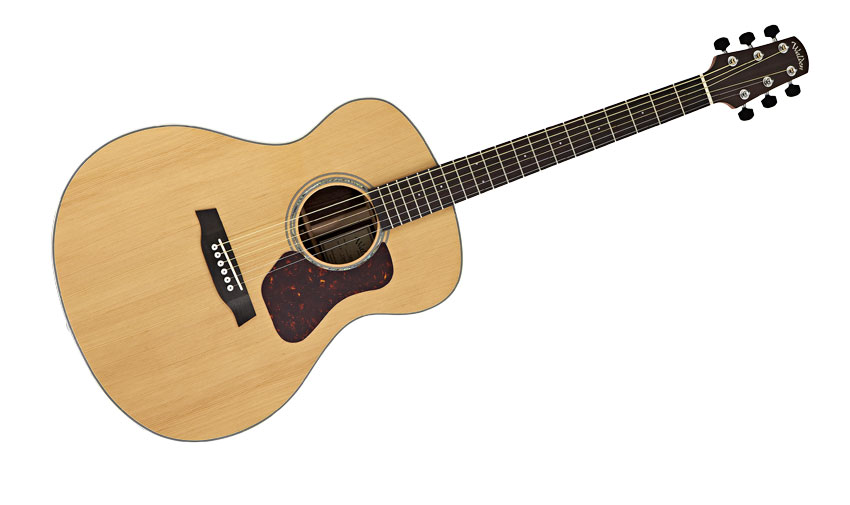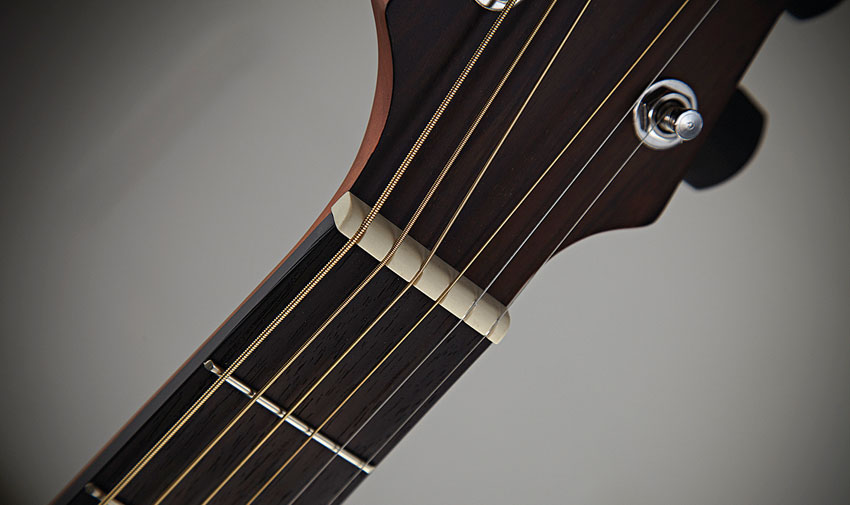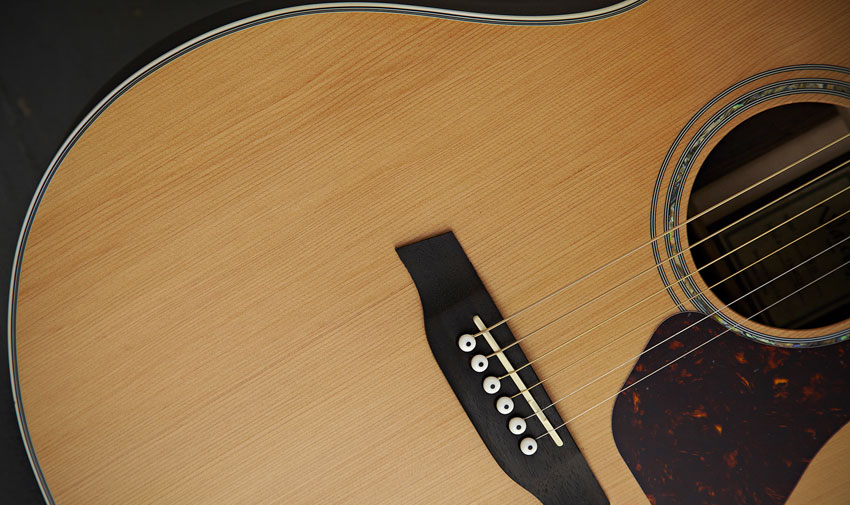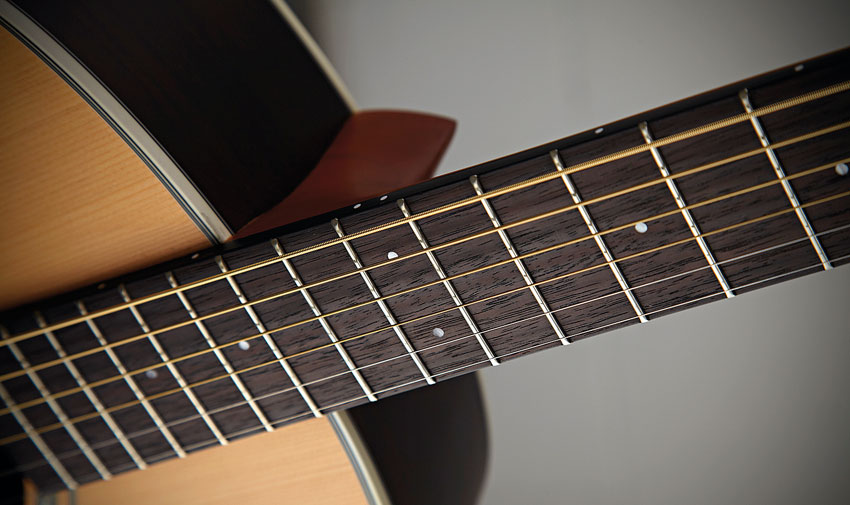MusicRadar Verdict
Like the D810, the near faultless, well-priced all-solid G830 just needs to live a little to really impress.
Pros
- +
Great features for the price. Solid wood tones will improve with age.
Cons
- -
Frets will need some TLC, initially.
MusicRadar's got your back

Walden G830

Nut

Body

Neck
On the face of it, Walden is yet another guitar brand looking to make a dent in the budget acoustic market. But this isn't your average Asian-made guitar; it has a serious boutique pedigree, thanks to the presence of ex-Charles Fox luthier John Lee in the design chair.
Like our Brit-designed and Asian-made Tanglewood and Faith brands, for example, Walden now also offers very affordable solid wood instruments, the previous start-point being the Condora level with SRPs of £635. Below that, the Natura 700 series boasted solid tops and backs with laminated sides at £359. Announced earlier this year, however, is the four-strong Natura 800 series that boasts all-solid Engelmann spruce or Western red cedar tops with solid Indian rosewood back and sides.
"If similarly spec'd guitars were made by Taylor, for example, you'd be looking at paying a couple of grand more"
The acoustic we have here comes from the most affordable end of the series, and costs just £407. So what? Well, if similarly spec'd guitars were made by Taylor, for example, you'd be looking at paying a couple of grand more.
Oh, and any vintage-obsessives out there, this (like all the 600, 700 and higher-end Walden guitars) features a nitrocellulose finish. On paper at least, here's a brand perfect for our penny-pinching times.
Punching above
Our sample is impressively clean in terms of build, not least the satin nitro finish, which not only looks extremely classy, it is evidently thin and very evenly applied. The internal scalloped X-bracing, lining and back brace all have commendable sharpness and the binding, purfling and the central back strip, not to mention the abalone centre soundhole rings, are all pin-sharp.
A little too sharp, perhaps, are the edges of the white plastic binding - a bigger curve here would help, especially if you're a bold strummer, to protect the skin on your inner right forearm.
The solid rosewood back and sides might not be the most decorative in terms of grain but the rich, deep chocolate hue is very appealing and barks quality, frankly well above its price.
"The guitar sports a very acceptable mahogany neck, too - quartersawn for maximum stiffness with a spliced headstock"
The guitar sports a very acceptable mahogany neck, too - quartersawn for maximum stiffness with a spliced headstock and an additional heel piece. It's a bolt-on and the large fixing-bolt is clearly visible on the neck block.
Hidden from view are two glass fibre reinforcement rods placed either side of the dual action truss that's adjustable through the soundhole. While the higher-level Waldens use carbon fibre rods and numerous brands, including Taylor and Takamine, use similar metal rods, we're not sure if we've encountered any other brands with glass fibre rods before.
Even though the guitar's fingerboard is constructed from bound rosewood and the small-gauge fretwork is pretty tidy, it needs a little TLC: the strings felt a little, well, cheap; the frets rather scratchily topped. That's common enough for a guitar at this price but it's unbelievable how a quick fret rub, a little fingerboard lemon oil and new strings transform it in terms of playing feel.
The nut and saddle, typically for Walden, is made from Graph Tech's Fossalite. It's good to see the compensated saddle, too, which produces excellent intonation. Yes, you'll need to add a little lubrication to those string grooves, but again, these minor setup issues are not exclusive to this brand at these prices.
Feel and sounds
With its slightly wider lower bouts and trimmer depth, not to mention its Western red cedar top, the G830 feels and sounds quite different to a generic dreadnought acoustic. It feels a little more comfortable played seated. The sound doesn't have a huge amount of low end and there's a bright edged 'new' voice. Yet as our playing time increases the G830's sound leans towards a fuller midrange.
The guitar records rather well. It sounds a little 'smaller' than a dreadnought (as you'd expect), for strummed parts but for lead lines there's a little more power especially up the fretboard. You'd expect a slightly rounder high-end with the cedar top and that's evident. As our sound test time increases we'd also suggest that the voicing of the guitar is becoming more noticeable: its individual character is emerging.
The last time we looked at a Walden was in issue 364 with the rather fine B1 acoustic baritone. That instrument's modernism isn't outwardly evident here: this guitar is more generic in style and sounds a little new; it also needed a little work and its nut slot sorting, especially if you're changing tunings a lot.
But par for the course? At this price, we think so. The guitar also utilises some usually higher-priced features, especially in the neck's construction, while the all-solid wood build means that you should really expect to hear a tonal improvement the more you play it. We'd honestly say we did.
It works well for recording and we'd definitely like to experiment with possibly a heavier string gauge and some richer sounding ropes. But at this price, either as a serious start-up guitar or more likely additional instrument, we'd suggest Walden is a brand that needs to be added to your audition list. This G830 is turning into quite a guitar.
Dave Burrluck is one of the world’s most experienced guitar journalists, who started writing back in the '80s for International Musician and Recording World, co-founded The Guitar Magazine and has been the Gear Reviews Editor of Guitarist magazine for the past two decades. Along the way, Dave has been the sole author of The PRS Guitar Book and The Player's Guide to Guitar Maintenance as well as contributing to numerous other books on the electric guitar. Dave is an active gigging and recording musician and still finds time to make, repair and mod guitars, not least for Guitarist’s The Mod Squad.
“We were arguing a lot and we were miserable”: How Green Day exceeded expectations with their most ambitious song
"There’s plenty for us guitarists to learn – and ‘less is more’ is the overriding lesson": how to play like George Harrison on The Beatles' Abbey Road
“They didn’t like Prince’s bikini underwear”: Prince’s support sets for the The Rolling Stones in 1981 are remembered as disastrous, but guitarist Dez Dickerson says that the the crowd reaction wasn’t as bad as people think










